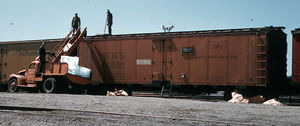Refrigerator car/Gallery: Difference between revisions
imported>Robert A. Estremo (relocate images / expand captions) |
imported>Robert A. Estremo m (reposition images) |
||
| Line 2: | Line 2: | ||
<gallery perrow=3 widths=300px heights=250px> | <gallery perrow=3 widths=300px heights=250px> | ||
Image:Central Pacific Fruit Train.jpg|{{Central Pacific Fruit Train.jpg/credit}}<br />A special fast fruit train leaving Central Pacific Railroad passenger station, June 24, 1886. This train was chartered by W. R. Strong & Co. and Edwin T. Earl, fruit packers and shippers, Sacramento. | Image:Central Pacific Fruit Train.jpg|{{Central Pacific Fruit Train.jpg/credit}}<br />A special fast fruit train leaving Central Pacific Railroad passenger station, June 24, 1886. This train was chartered by W. R. Strong & Co. and Edwin T. Earl, fruit packers and shippers, Sacramento. | ||
Image:Union Refrigerator Line 6699.jpg|{{Union Refrigerator Line 6699.jpg/credit}}<br />Union Refrigerator Line refrigerator car #6699, used to transport milk, cheese, and eggs. | Image:Union Refrigerator Line 6699.jpg|{{Union Refrigerator Line 6699.jpg/credit}}<br />Union Refrigerator Line refrigerator car #6699, used to transport milk, cheese, and eggs. | ||
Image:MDT East Rochester car shops ''circa'' 1905.jpg|{{MDT East Rochester car shops ''circa'' 1905.jpg/credit}}<br />Rows of reefers in various stages of construction fill MDT's car shop, ''circa'' 1905. | Image:MDT East Rochester car shops ''circa'' 1905.jpg|{{MDT East Rochester car shops ''circa'' 1905.jpg/credit}}<br />Rows of reefers in various stages of construction fill MDT's car shop, ''circa'' 1905. | ||
Image:Interior of ice bunker reefer.jpg|{{Interior of ice bunker reefer.jpg/credit}}<br />The interior of a typical ice-bunker reefer from the 1920s; the wood sheathing would give way to plywood within twenty years. Vents in the bunker at the end of the car, along with slots in the wood floor racks, allowed cool air to circulate around the contents during transit. | Image:Interior of ice bunker reefer.jpg|{{Interior of ice bunker reefer.jpg/credit}}<br />The interior of a typical ice-bunker reefer from the 1920s; the wood sheathing would give way to plywood within twenty years. Vents in the bunker at the end of the car, along with slots in the wood floor racks, allowed cool air to circulate around the contents during transit. | ||
Image:Swift Brands Sioux City, Iowa meat packing plant.jpg|{{Swift Brands Sioux City, Iowa meat packing plant.jpg/credit}}<br />A view of the Swift Brands [[Sioux City, Iowa]] meat packing plant, ''circa'' 1917. All but one of the refrigerator cars in the photo bear the markings of the Swift Refrigerator Line. | Image:Swift Brands Sioux City, Iowa meat packing plant.jpg|{{Swift Brands Sioux City, Iowa meat packing plant.jpg/credit}}<br />A view of the Swift Brands [[Sioux City, Iowa]] meat packing plant, ''circa'' 1917. All but one of the refrigerator cars in the photo bear the markings of the Swift Refrigerator Line. | ||
| Line 17: | Line 17: | ||
Image:REA Express refrigerator.jpg|{{REA Express refrigerator.jpg/credit}}<br />Railway Express Agency refrigerator car #6687, a converted WWII Troop Sleeper. | Image:REA Express refrigerator.jpg|{{REA Express refrigerator.jpg/credit}}<br />Railway Express Agency refrigerator car #6687, a converted WWII Troop Sleeper. | ||
Image:FM REA 65.jpg|{{FM REA 65.jpg/credit}}<br />An REA express reefer is positioned at the head end of Santa Fe train No.8, the ''Fast Mail'', in 1965. | Image:FM REA 65.jpg|{{FM REA 65.jpg/credit}}<br />An REA express reefer is positioned at the head end of Santa Fe train No.8, the ''Fast Mail'', in 1965. | ||
Image:Intermodal freight February 1995.jpg|{{Intermodal freight February 1995.jpg/credit}}<br />A westbound intermodal freight train passes through the Cajon Pass, Mile Post 54, in February 1995. | Image:Intermodal freight February 1995.jpg|{{Intermodal freight February 1995.jpg/credit}}<br />A westbound intermodal freight train passes through the Cajon Pass, Mile Post 54, in February 1995. | ||
Image:TPIX 250.jpg|{{TPIX 250.jpg/credit}}<br />Tropicana refrigerated box car #250. | Image:TPIX 250.jpg|{{TPIX 250.jpg/credit}}<br />Tropicana refrigerated box car #250. | ||
Image:Kuehlwagen Interfrigo.jpg|{{Kuehlwagen Interfrigo.jpg/credit}}<br />Outside of North America, railroad cars which have been outfitted with cooling equipment (and designated as Class "I" by the International Union of Railways [UIC]) are generally referred to as "refrigerated vans." | Image:Kuehlwagen Interfrigo.jpg|{{Kuehlwagen Interfrigo.jpg/credit}}<br />Outside of North America, railroad cars which have been outfitted with cooling equipment (and designated as Class "I" by the International Union of Railways [UIC]) are generally referred to as "refrigerated vans." | ||
Image:MDT-GMO 12530.jpg|{{MDT-GMO 12530.jpg/credit}}<br />An early version of a field icing car loads a Merchants Despatch Transportation Co. reefer (bearing the herald of the GM&O) in Norfolk, Virginia in April 1955. | Image:MDT-GMO 12530.jpg|{{MDT-GMO 12530.jpg/credit}}<br />An early version of a field icing car loads a Merchants Despatch Transportation Co. reefer (bearing the herald of the GM&O) in Norfolk, Virginia in April 1955. | ||
</gallery> | </gallery> | ||
==Notes and references== | ==Notes and references== | ||
Revision as of 19:28, 14 August 2013
(PD) Photo: Swift Brands
A view of the Swift Brands Sioux City, Iowa meat packing plant, circa 1917. All but one of the refrigerator cars in the photo bear the markings of the Swift Refrigerator Line.© Image: Orange Public Library
A crate label for Hewes' Transcontinental Brand of El Modena, California, circa 1930 depicts a trainload of Pacific Fruit Express (PFE) ventilated refrigerator cars passing near San Francisco Bay.(PD) Photo: William B. Barry
A Swift refrigerator car has reached the end-of-the-line at East Orange, New Jersey. The car has been repainted and was photographed in mid- or late-1937, after the use of "billboard" advertising on freight cars had been banned by the Interstate Commerce Commission, and such cars could no longer be accepted for interchange between roads.

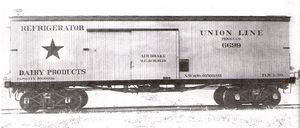
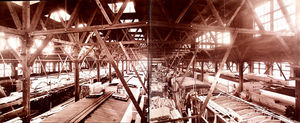
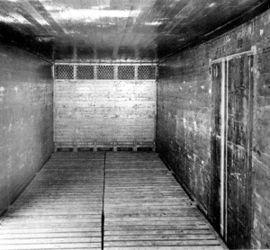
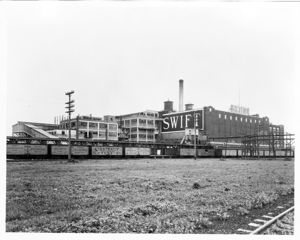
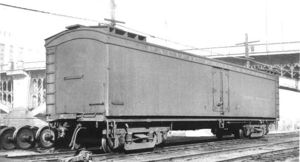


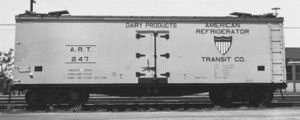
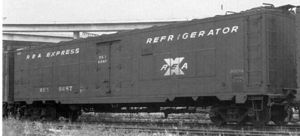
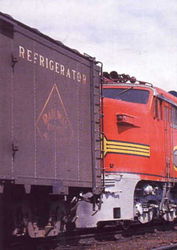
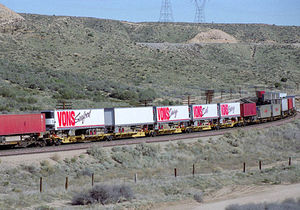
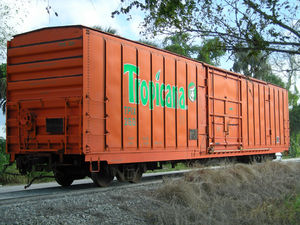
![(PD) Photo: Garitzko Outside of North America, railroad cars which have been outfitted with cooling equipment (and designated as Class "I" by the International Union of Railways [UIC]) are generally referred to as "refrigerated vans."](/wiki/images/thumb/9/92/Kuehlwagen_Interfrigo.jpg/300px-Kuehlwagen_Interfrigo.jpg)
